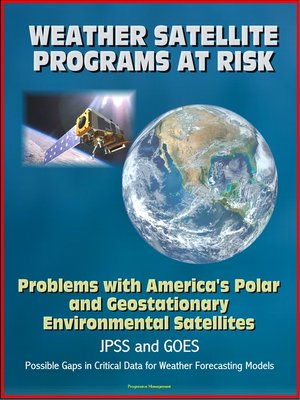Weather Satellite Programs at Risk
ebook ∣ Problems with America's Polar and Geostationary Environmental Satellites, JPSS and GOES, Possible Gaps in Critical Data for Weather Forecasting Models
By Progressive Management

Sign up to save your library
With an OverDrive account, you can save your favorite libraries for at-a-glance information about availability. Find out more about OverDrive accounts.
Find this title in Libby, the library reading app by OverDrive.



Search for a digital library with this title
Title found at these libraries:
| Loading... |
This is a comprehensive collection of investigative reports and official information about the vital issue of America's polar and geostationary weather observation satellites. Prolonged delays in the development program of these satellites threatens to create a dangerous gap in coverage, adversely affecting the accuracy of critical weather forecasts.The United States relies on two complementary types of satellite systems for weather observations and forecasts: (1) polar-orbiting satellites that provide a global perspective every morning and afternoon and (2) geostationary satellites that maintain a fixed view of the United States. Both types of systems are critical to weather forecasters, climatologists, and the military to map and monitor changes in weather, climate, the oceans, and the environment. Federal agencies are currently planning and executing major satellite acquisition programs to replace existing polar and geostationary satellite systems that are nearing the end of their expected life spans. However, these programs have troubled legacies of cost increases, missed milestones, technical problems, and management challenges that have resulted in reduced functionality and slips to planned launch dates. As a result, the continuity of satellite data is at risk.Officials from the Department of Commerce's National Oceanic and Atmospheric Administration (NOAA) acknowledge that there is a substantial risk of a gap in polar satellite data in the afternoon orbit, between the time that the current polar satellite is expected to reach the end of its life and the time when the next satellite is expected to be in orbit and operational. This gap could span from 17 to 53 months or more, depending on how long the current satellite lasts and any delays in launching or operating the new one. There is also a risk of a gap in the early morning orbit if the Department of Defense's next satellites do not work as intended. According to civilian and military satellite experts, this is a possibility because the two remaining satellites have been in storage for over a decade and will be quite old by the time they are launched. Similarly, while federal agencies do not anticipate gaps in geostationary satellite observations, such a gap could occur if satellites currently in orbit do not last as long as anticipated or if the major satellite acquisition currently underway encounters schedule delays.According to NOAA program officials, a satellite data gap would result in less accurate and timely weather forecasts and warnings of extreme events, such as hurricanes, storm surges and floods. Such degradation in forecasts and warnings would place lives, property, and our nation's critical infrastructures in danger. Given the criticality of satellite data to weather forecasts, the likelihood of significant gaps and the potential impact of such gaps on the health and safety of the U.S. population and economy, GAO has concluded that the potential gap in weather satellite data is a high-risk area and added it to the High Risk List in 2013. NOAA faces ongoing challenges in ensuring the continuity of satellite operations in both the polar-orbiting and geostationary environmental satellite programs.






